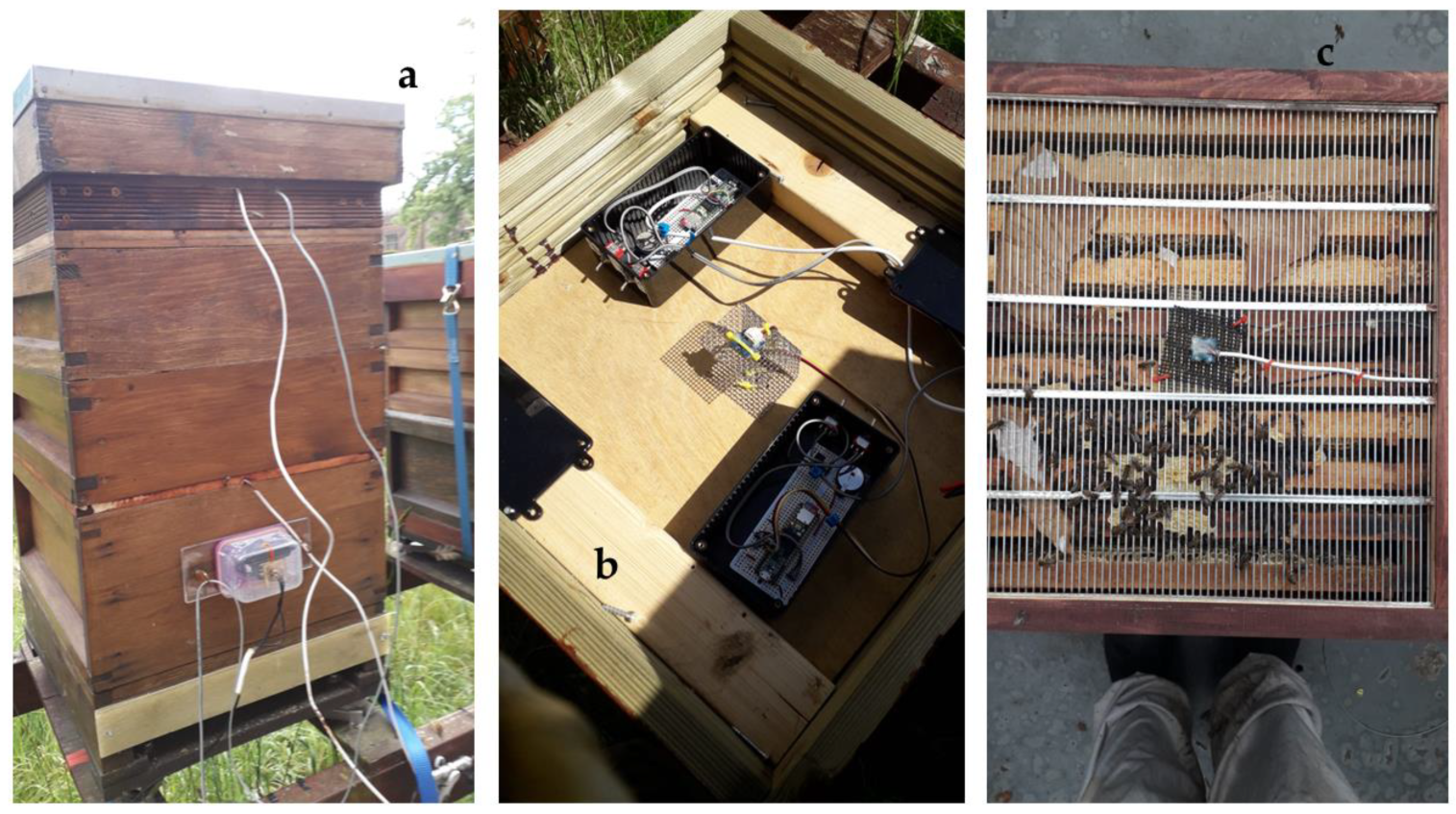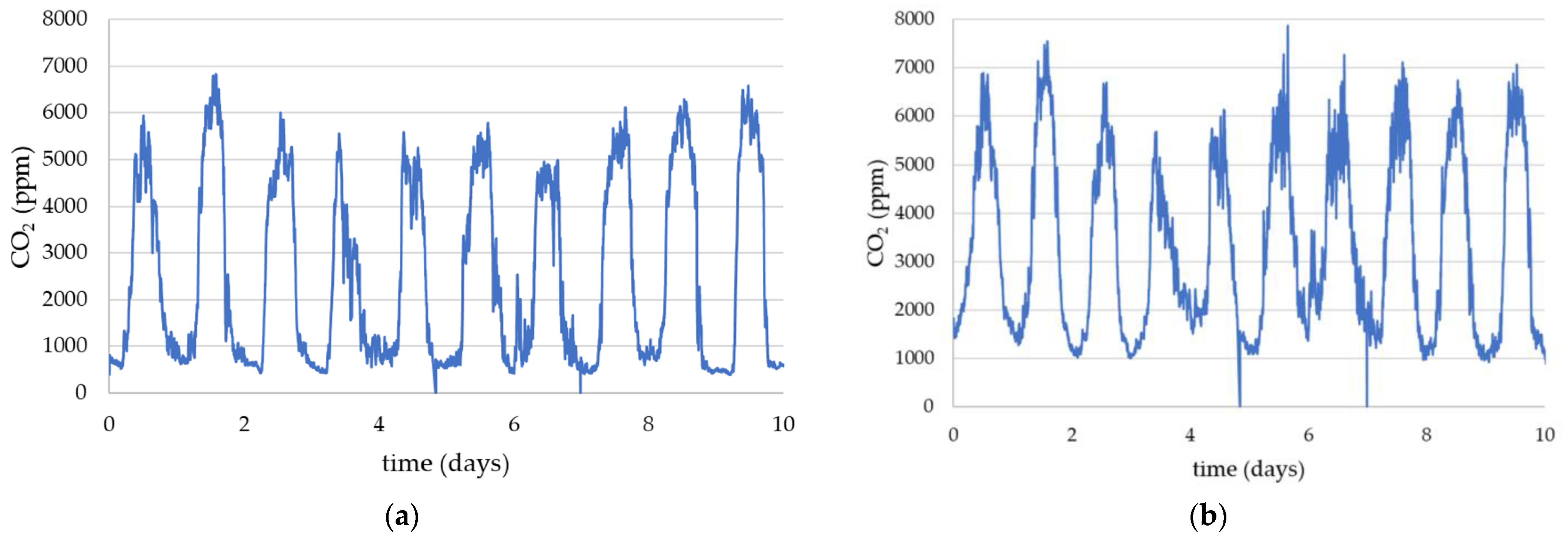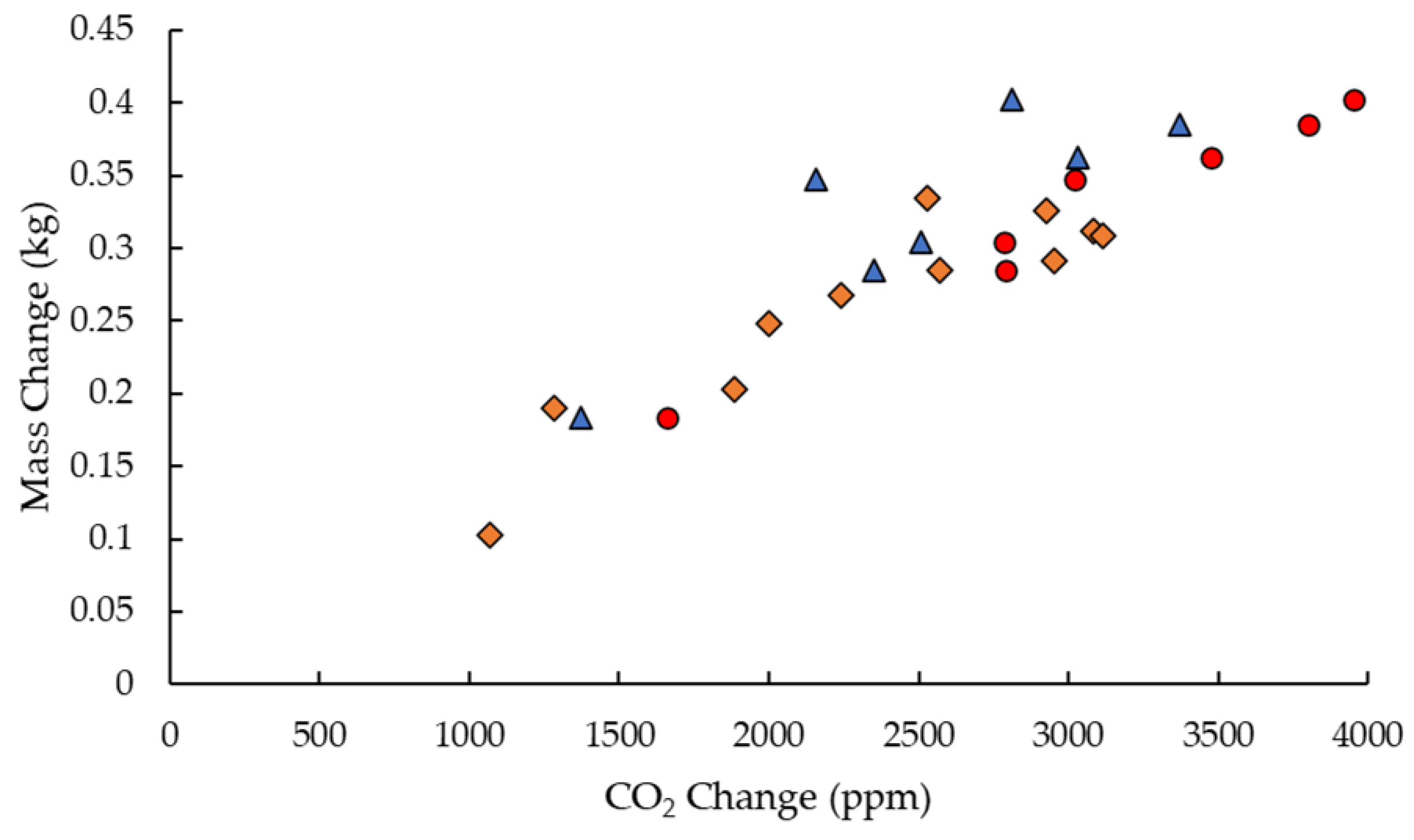A Monitoring System for Carbon Dioxide in Honeybee Hives: An Indicator of Colony Health
Abstract
1. Introduction
2. Materials and Methods
3. Results
4. Discussion
5. Conclusions
Author Contributions
Funding
Institutional Review Board Statement
Data Availability Statement
Acknowledgments
Conflicts of Interest
References
- Kraus, B.; Velthuis, H.H.W. High humidity in the honey bee (Apis mellifera L.) brood nest limits reproduction of the parasitic mite Varroa jacobsoni Oud. Naturwissenschaften 1997, 84, 217–218. [Google Scholar] [CrossRef]
- Human, H.; Nicolson, S.W.; Dietemann, V. Do honeybees, Apis mellifera scutellata, regulate humidity in their nest? Naturwissenschaften 2006, 93, 397–401. [Google Scholar] [CrossRef]
- Sánchez, V.; Gil, S.; Flores, J.M.; Quiles, F.J.; Ortiz, M.A.; Luna, J.J. Implementation of an electronic system to monitor the thermoregulatory capacity of honeybee colonies in hives with open-screened bottom boards. Comput. Electron. Agr. 2015, 119, 209–216. [Google Scholar] [CrossRef]
- Ayton, S.; Tomlinson, S.; Phillips, R.D.; Dixon, K.W.; Withers, P.C. Phenophysiological variation of a bee that regulates hive humidity, but not hive temperature. J. Exp. Biol. 2016, 219, 1552–1562. [Google Scholar] [CrossRef] [PubMed]
- Li, Z.; Huang, Z.Y.; Sharma, D.B.; Xue, Y.; Wang, Z.; Ren, B. Drone and worker brood microclimates are regulated differentially in honey bees, Apis mellifera. PLoS ONE 2016, 11, e0148740. [Google Scholar] [CrossRef] [PubMed]
- Abou-Shaara, H.F.; Owayss, A.A.; Ibrahim, Y.Y.; Basuny, N.K. A review of impacts of temperature and relative humidity on various activities of honey bees. Insect. Soc. 2017, 64, 455–463. [Google Scholar] [CrossRef]
- Meikle, W.G.; Weiss, M.; Maes, P.W.; Fitz, W.; Snyder, L.A.; Sheehan, T.; Mott, B.M.; Anderson, K.E. Internal hive temperature as a means of monitoring honey bee colony health in a migratory beekeeping operation before and during winter. Apidologie 2017, 48, 666–680. [Google Scholar] [CrossRef]
- Ma, W.; Li, X.; Shen, J.; Du, Y.; Xu, K.; Jiang, Y. Transcriptomic analysis reveals Apis mellifera adaptations to high temperature and high humidity. Ecotoxicol. Environ. Saf. 2019, 184, 109599. [Google Scholar] [CrossRef]
- LiI, X.; Ma, W.; Shen, J.; Long, D.; Feng, Y.; Su, W.; Xu, K.; Du, Y.; Jiang, Y. Tolerance and response of two honeybee species Apis cerana and Apis mellifera to high temperature and relative humidity. PLoS ONE 2019, 14, e0217921. [Google Scholar] [CrossRef]
- Ellis, M.B. Homeostasis: Humidity and Water Relations in Honeybee Colonies (Apis mellifera). Ph.D. Thesis, Magister Scientiae University of Pretoria, Pretoria, South Africa, November 2008. Available online: https://repository.up.ac.za/bitstream/handle/2263/28357/dissertation.pdf (accessed on 25 March 2023).
- Seeley, T.D. Atmospheric carbon dioxide regulation in honey-bee (Apis mellifera) colonies. J. Insect Physiol. 1974, 20, 2301–2305. [Google Scholar] [CrossRef]
- Robinson, G.E.; Visscher, P.K. Effect of low temperature narcosis on honey Bee (Hymenoptera: Apidae) foraging behavior. Fla. Entomol. 1984, 67, 568–570. [Google Scholar] [CrossRef]
- Stec, D.; Kuszewska, K. CO2 narcosis influences the memory of honey bees. J. Apicul. Res. 2020, 59, 663–668. [Google Scholar] [CrossRef]
- Cecchi, S.; Terenzi, A.; Orcioni, S.; Spinsante, S.; Primiani, V.M.; Moglie, F.; Ruschioni, S.; Mattei, C.; Riolo, P.; Isidoro, N. Multi-sensor platform for real time measurements of honey bee hive parameters. IOP C. Ser. Earth Env. 2019, 275, 012016. [Google Scholar] [CrossRef]
- Cecchi, S.; Spinsante, S.; Terenzi, A.; Orcioni, S. A smart sensor-based measurement system for advanced bee hive monitoring. Sensors 2020, 20, 2726. [Google Scholar] [CrossRef]
- Meikle, W.G.; Adamczyk, J.J.; Weiss, M.; Ross, J.; Werle, C.; Beren, E. Sublethal concentrations of clothianidin affect honey bee colony growth and hive CO2 concentration. Sci. Rep. 2021, 11, 4364. [Google Scholar] [CrossRef]
- Meikle, W.G.; Barg, A.; Weiss, M. Honey bee colonies maintain CO2 and temperature regimes in spite of change in hive ventilation characteristics. Apidologie 2022, 53, 51. [Google Scholar] [CrossRef]
- Leonard, R.J.; Vergoz, V.; Proschogo, N.; McArthur, C.; Hochuli, D.F. Petrol exhaust pollution impairs honey bee learning and memory. Oikos 2018, 128, 264–273. [Google Scholar] [CrossRef]
- Ginevan, M.E.; Lane, D.D.; Greenberg, L. Ambient air concentration of sulfur dioxide affects flight activity in bees. Proc. Natl. Acad. Sci. USA 1980, 77, 5631–5633. [Google Scholar] [CrossRef]
- Reitmayer, C.M.; Ryalls, J.M.W.; Farthing, E.; Jackson, C.W.; Girling, R.D.; Newman, T.A. Acute exposure to diesel exhaust induces central nervous system stress and altered learning and memory in honey bees. Sci. Rep. 2019, 9, 5793. [Google Scholar] [CrossRef]
- i2c Standard. Available online: https://web.archive.org/web/20210813122132/https://www.nxp.com/docs/en/user-guide/UM10204.pdf (accessed on 6 February 2023).
- SGP30 Product Information. Available online: https://sensirion.com/products/catalog/SGP30/ (accessed on 6 February 2023).
- iaQ Core Product Information. Available online: https://www.sciosense.com/wp-content/uploads/2020/01/iaQ-Core-Datasheet.pdf (accessed on 6 February 2023).
- CCS811 Product Information. Available online: https://www.sciosense.com/products/air-quality-sensors-environmental-sensors/ccs811/ (accessed on 6 February 2023).
- BME680 Product Information. Available online: https://www.bosch-sensortec.com/products/environmental-sensors/gas-sensors/ (accessed on 6 February 2023).
- Available online: https://www.Adafruit.com (accessed on 6 February 2023).
- Available online: https://www.Sparkfun.com (accessed on 6 February 2023).
- Yurko, G.; Roostaei, J.; Dittrich, T.; Xu, L.; Ewing, M.; Zhang, Y.; Shreve, G. Real-time sensor response characteristics of 3 commercial metal oxide sensors for detection of BTEX and chlorinated aliphatic hydrocarbon organic vapors. Chemosensors 2019, 7, 40. [Google Scholar] [CrossRef]
- Lasomsri, P.; Yanbuaban, P.; Kerdpoca, O.; Ouypornkochagorn, T. A development of low-cost devices for monitoring indoor air quality in a large-scale hospital. In Proceedings of the 2018 15th International Conference on Electrical Engineering/Electronics, Computer, Telecommunications and Information Technology (ECTI-CON), Chiang Rai, Thailand, 18–21 July 2018; pp. 286–289. [Google Scholar] [CrossRef]
- Arroyo, P.; Meléndez, F.; Suárez, J.; Herrero, J.; Rodríguez, S.; Lozano, J. Electronic nose with digital gas sensors connected via bluetooth to a smartphone for air quality measurements. Sensors 2020, 20, 786. [Google Scholar] [CrossRef] [PubMed]
- Sensirion SCD30 Product Information. Available online: https://sensirion.com/products/catalog/SCD30/ (accessed on 6 February 2023).
- Teledyne T6713 Product Information. Available online: https://www.amphenol-sensors.com/en/telaire/co2 (accessed on 6 February 2023).
- Figaro CDM7162 Product Information. Available online: https://www.figaro.co.jp/en/product/entry/cdm7162.html (accessed on 6 February 2023).
- MH-Z19b Product Information. Available online: https://www.winsen-sensor.com/d/files/infrared-gas-sensor/mh-z19b-co2-ver1_0.pdf (accessed on 6 February 2023).
- Senserion SCD41 Product Information. Available online: https://sensirion.com/media/documents/E0F04247/631EF271/CD_DS_SCD40_SCD41_Datasheet_D1.pdf (accessed on 6 February 2023).
- BEEP Product Information. Available online: https://beep.nl/index.php/measurement-system-2 (accessed on 1 February 2023).
- SEEED Studio Product Information. Available online: https://wiki.seeedstudio.com/Grove-CO2-Temperature-Humidity-Sensor-SCD41/ (accessed on 1 February 2023).
- Harbo, J.R. Effect of brood rearing on honey consumption and the survival of worker honey bees. J. Apic. Res. 1993, 32, 11–17. [Google Scholar] [CrossRef]
- Meikle, W.G.; Rector, B.G.; Mercadier, G.; Holst, N. Within-day variation in continuous hive weight data as a measure of honey bee colony activity. Apidologie 2008, 39, 694–707. [Google Scholar] [CrossRef]







Disclaimer/Publisher’s Note: The statements, opinions and data contained in all publications are solely those of the individual author(s) and contributor(s) and not of MDPI and/or the editor(s). MDPI and/or the editor(s) disclaim responsibility for any injury to people or property resulting from any ideas, methods, instructions or products referred to in the content. |
© 2023 by the authors. Licensee MDPI, Basel, Switzerland. This article is an open access article distributed under the terms and conditions of the Creative Commons Attribution (CC BY) license (https://creativecommons.org/licenses/by/4.0/).
Share and Cite
Bencsik, M.; McVeigh, A.; Tsakonas, C.; Kumar, T.; Chamberlain, L.; Newton, M.I. A Monitoring System for Carbon Dioxide in Honeybee Hives: An Indicator of Colony Health. Sensors 2023, 23, 3588. https://doi.org/10.3390/s23073588
Bencsik M, McVeigh A, Tsakonas C, Kumar T, Chamberlain L, Newton MI. A Monitoring System for Carbon Dioxide in Honeybee Hives: An Indicator of Colony Health. Sensors. 2023; 23(7):3588. https://doi.org/10.3390/s23073588
Chicago/Turabian StyleBencsik, Martin, Adam McVeigh, Costas Tsakonas, Tarun Kumar, Luke Chamberlain, and Michael I. Newton. 2023. "A Monitoring System for Carbon Dioxide in Honeybee Hives: An Indicator of Colony Health" Sensors 23, no. 7: 3588. https://doi.org/10.3390/s23073588
APA StyleBencsik, M., McVeigh, A., Tsakonas, C., Kumar, T., Chamberlain, L., & Newton, M. I. (2023). A Monitoring System for Carbon Dioxide in Honeybee Hives: An Indicator of Colony Health. Sensors, 23(7), 3588. https://doi.org/10.3390/s23073588








